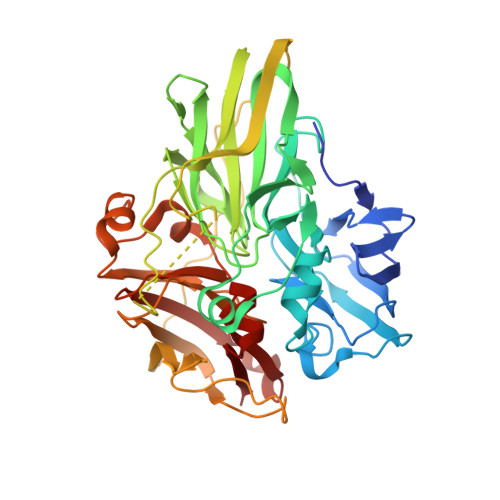Activity enhancement of multicopper oxidase from a hyperthermophile via directed evolution, and its application as the element of a high performance biocathode.
Satomura, T., Hirano, T., Inagaki, K., Horinaga, K., Takamura, E., Sakamoto, H., Ohshida, T., Ohshima, T., Sakuraba, H., Suye, S.I.(2021) J Biotechnol 325: 226-232
- PubMed: 33164755
- DOI: https://doi.org/10.1016/j.jbiotec.2020.10.019
- Primary Citation of Related Structures:
6K3D - PubMed Abstract:
Although multicopper oxidase from the hyperthermophilic archaeon Pyrobaculum aerophilum (McoP) can be particularly useful in biotechnological applications, e.g., as a specific catalyst at the biocathode of biofuel cells (BFCs), owing to its high stability against extremely high temperatures and across a wide range of pH values, this application potential remains limited due to the enzyme's low catalytic activity. A directed evolution strategy was conducted to improve McoP catalytic activity, and the No. 571 mutant containing four amino acid substitutions was identified, with specific activity approximately 9-fold higher than that of the wild type enzyme. Among the substitutions, the single amino acid mutant F290I was essential in enhancing catalytic activity, with a specific activity approximately 12-fold higher than that of the wild type enzyme. F290I thermostability and pH stability were notably comparable with values obtained for the wild type. Crystal structure analysis suggested that the F290I mutant increased loop flexibility near the T1 Cu center, and affected electron transfer between the enzyme and substrate. Additionally, electric current density of the F290I mutant-immobilized electrode was 7-fold higher than that of the wild type-immobilized one. These results indicated that F290I mutant was a superior catalyst with potential in practical biotechnological applications.
- Division of Engineering, Faculty of Engineering, University of Fukui, 3-9-1 Bunkyo, Fukui 910-8507, Japan; Life Science Innovation Center, University of Fukui, 3-9-1 Bunkyo, Fukui 910-8507, Japan. Electronic address: satomura@u-fukui.ac.jp.
Organizational Affiliation:


















